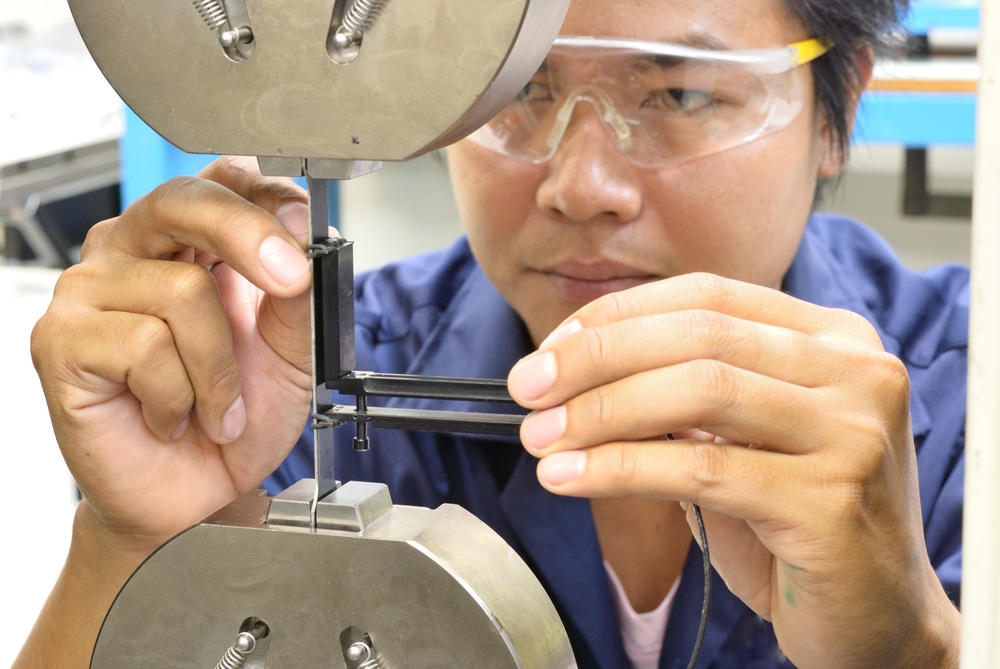Carbon fibers go all the way back to Thomas Edison’s invention of the first incandescent light bulb in 1879 with the help of Lewis Latimer’s invention of “carbonized cotton threads and bamboo slivers to make the filaments for the bulbs.” Carbon fibers for use in structural materials started to be developed near the end of World War I. Union Carbide began investigating a replacement for tungsten wire in vacuum tubes by carbonizing rayon. In 1958, they developed a carbonized rayon cloth and submitted it to the U.S. Air Force as a replacement for fiberglass in rocket nozzle exit cones and re-entry heat shields.
The modern era of carbon fibers began in 1956, when Union Carbide’s Dr. Roger Bacon demonstrated the first high-performance carbon fibers in 1958. In fibrous forms, carbon and graphite are the strongest and stiffest materials for their weight that have ever been produced with a tensile strength of 20 Gigapascals (GPa) and Young’s modulus of 700 GPa. In 1959, Union Carbide scientists Curry Ford and Charles Mitchell patented a process for making fibers and cloths by heat-treating rayon to high temperatures, up to 3,000 °C. They had produced the strongest commercial carbon fibers to date, which led to the entry of carbon fibers into the “advanced composites” industry in 1963. The first truly high modulus commercial carbon fibers were invented in 1964, when Bacon and Wesley Schalamon made fibers from rayon using a new “hot-stretching” process. They stretched the carbon yarn at high temperatures (more than 2800° C), orienting the graphite layers to lie nearly parallel with the fiber axis. The process resulted in a ten-fold increase in Young’s modulus—a major step on the way to duplicating the properties of Bacon’s graphite whiskers.
While researchers in the United States were reveling in rayon, scientists overseas were busy creating their own carbon fiber industries based on polyacrylonitrile, or PAN. In 1961, Japanese researchers demonstrated high strength and high modulus fibers from PAN precursors. Akio Shindo of the Government Industrial Research Institute in Osaka, Japan, made fibers in the lab with a modulus of more than 140 GPa, about three times that of rayon-based fibers at the time. Shindo’s process was quickly taken up by other Japanese researchers, leading to pilot-scale production in 1964. In that same year, William Watt of the Royal Aircraft Establishment in England invented a still higher-modulus fiber from PAN. The British fibers were rapidly put into commercial production through licenses to Rolls-Royce, Morganite; and Courtaulds. The Japanese eventually took the lead in manufacturing PAN-based carbon fibers, effectively beating the British at their own game. Japan’s Toray Industries developed a precursor that was far superior to anything seen before, and in 1970 they signed a joint technology agreement with Union Carbide, bringing the United States back to the forefront in carbon fiber manufacturing.
PAN and rayon are both non-graphitizing materials, so carbon fibers from these precursors will never be truly graphitic, even after heat treatment to high temperatures. To make the next generation of carbon fibers, scientists needed a new starting material. Union Carbide’s Leonard Singer studied the underlying mechanism of carbonization, which involved heating various petroleum and coal-based materials. Heating organic substances like these inevitably leads to the formation of a pitch, a tar-like mixture of hundreds of branched compounds with different molecular weights. In 1970 Singer and his assistant, Allen Cherry, designed a “taffy-pulling” machine that applied stress to the viscous mesophase to align the molecules, and then heated the material to convert it to a highly oriented carbon fiber. The process worked, and subsequent analyses verified that they had made highly-oriented graphitizable carbon fibers. The physical properties of these graphitized mesophase pitch fibers were astounding. Not only did they have an ultrahigh elastic modulus, approaching 1,000 GPa, but these were also the first carbon fibers with ultrahigh thermal conductivity (3-4X of copper). This made them especially useful for any application where stiffness and heat removal were important, such as aircraft brakes and electronic circuits.
Nearly all commercial carbon fibers produced today are based on rayon, PAN or pitch. Approximately 92% of the carbon fiber produced today is PAN based. It offers the combination of worldwide availability, structural properties, and demonstrated composite performance. Pitch-based fibers are unique in their ability to achieve ultrahigh Young’s modulus and thermal conductivity and, therefore, have found an assured place in critical military and space applications. But their high cost has kept production to a minimum; only a few companies are currently producing them.















